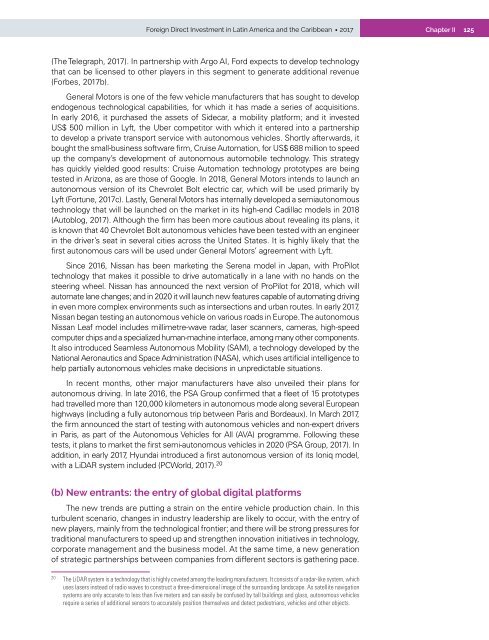Foreign Direct Investment in Latin America and the Caribbean 2017
This publication sets out and analyses the main foreign direct investment (FDI) trends in the countries of Latin America and the Caribbean. The 2017 edition shows that the region is at a difficult juncture. FDI inflows declined by 7.9% in 2016, to US$ 167.043 billion, representing a cumulative fall of 17.0% since the peak in 2011. The fall in commodity prices continues to affect investments in natural resources, sluggish economic growth in several countries has slowed the flow of market-seeking capital, and the global backdrop of technological sophistication and expansion of the digital economy has concentrated transnational investments in developed economies.
This publication sets out and analyses the main foreign direct investment (FDI) trends in the countries of Latin America and the Caribbean. The 2017 edition shows that the region is at a difficult juncture. FDI inflows declined by 7.9% in 2016, to US$ 167.043 billion, representing a cumulative fall of 17.0% since the peak in 2011. The fall in commodity prices continues to affect investments in natural resources, sluggish economic growth in several countries has slowed the flow of market-seeking capital, and the global backdrop of technological sophistication and expansion of the digital economy has concentrated transnational investments in developed economies.
Create successful ePaper yourself
Turn your PDF publications into a flip-book with our unique Google optimized e-Paper software.
<strong>Foreign</strong> <strong>Direct</strong> <strong>Investment</strong> <strong>in</strong> Lat<strong>in</strong> <strong>America</strong> <strong>and</strong> <strong>the</strong> <strong>Caribbean</strong> • <strong>2017</strong><br />
Chapter II<br />
125<br />
(The Telegraph, <strong>2017</strong>). In partnership with Argo AI, Ford expects to develop technology<br />
that can be licensed to o<strong>the</strong>r players <strong>in</strong> this segment to generate additional revenue<br />
(Forbes, <strong>2017</strong>b).<br />
General Motors is one of <strong>the</strong> few vehicle manufacturers that has sought to develop<br />
endogenous technological capabilities, for which it has made a series of acquisitions.<br />
In early 2016, it purchased <strong>the</strong> assets of Sidecar, a mobility platform; <strong>and</strong> it <strong>in</strong>vested<br />
US$ 500 million <strong>in</strong> Lyft, <strong>the</strong> Uber competitor with which it entered <strong>in</strong>to a partnership<br />
to develop a private transport service with autonomous vehicles. Shortly afterwards, it<br />
bought <strong>the</strong> small-bus<strong>in</strong>ess software firm, Cruise Automation, for US$ 688 million to speed<br />
up <strong>the</strong> company’s development of autonomous automobile technology. This strategy<br />
has quickly yielded good results: Cruise Automation technology prototypes are be<strong>in</strong>g<br />
tested <strong>in</strong> Arizona, as are those of Google. In 2018, General Motors <strong>in</strong>tends to launch an<br />
autonomous version of its Chevrolet Bolt electric car, which will be used primarily by<br />
Lyft (Fortune, <strong>2017</strong>c). Lastly, General Motors has <strong>in</strong>ternally developed a semiautonomous<br />
technology that will be launched on <strong>the</strong> market <strong>in</strong> its high-end Cadillac models <strong>in</strong> 2018<br />
(Autoblog, <strong>2017</strong>). Although <strong>the</strong> firm has been more cautious about reveal<strong>in</strong>g its plans, it<br />
is known that 40 Chevrolet Bolt autonomous vehicles have been tested with an eng<strong>in</strong>eer<br />
<strong>in</strong> <strong>the</strong> driver’s seat <strong>in</strong> several cities across <strong>the</strong> United States. It is highly likely that <strong>the</strong><br />
first autonomous cars will be used under General Motors’ agreement with Lyft.<br />
S<strong>in</strong>ce 2016, Nissan has been market<strong>in</strong>g <strong>the</strong> Serena model <strong>in</strong> Japan, with ProPilot<br />
technology that makes it possible to drive automatically <strong>in</strong> a lane with no h<strong>and</strong>s on <strong>the</strong><br />
steer<strong>in</strong>g wheel. Nissan has announced <strong>the</strong> next version of ProPilot for 2018, which will<br />
automate lane changes; <strong>and</strong> <strong>in</strong> 2020 it will launch new features capable of automat<strong>in</strong>g driv<strong>in</strong>g<br />
<strong>in</strong> even more complex environments such as <strong>in</strong>tersections <strong>and</strong> urban routes. In early <strong>2017</strong>,<br />
Nissan began test<strong>in</strong>g an autonomous vehicle on various roads <strong>in</strong> Europe. The autonomous<br />
Nissan Leaf model <strong>in</strong>cludes millimetre-wave radar, laser scanners, cameras, high-speed<br />
computer chips <strong>and</strong> a specialized human-mach<strong>in</strong>e <strong>in</strong>terface, among many o<strong>the</strong>r components.<br />
It also <strong>in</strong>troduced Seamless Autonomous Mobility (SAM), a technology developed by <strong>the</strong><br />
National Aeronautics <strong>and</strong> Space Adm<strong>in</strong>istration (NASA), which uses artificial <strong>in</strong>telligence to<br />
help partially autonomous vehicles make decisions <strong>in</strong> unpredictable situations.<br />
In recent months, o<strong>the</strong>r major manufacturers have also unveiled <strong>the</strong>ir plans for<br />
autonomous driv<strong>in</strong>g. In late 2016, <strong>the</strong> PSA Group confirmed that a fleet of 15 prototypes<br />
had travelled more than 120,000 kilometers <strong>in</strong> autonomous mode along several European<br />
highways (<strong>in</strong>clud<strong>in</strong>g a fully autonomous trip between Paris <strong>and</strong> Bordeaux). In March <strong>2017</strong>,<br />
<strong>the</strong> firm announced <strong>the</strong> start of test<strong>in</strong>g with autonomous vehicles <strong>and</strong> non-expert drivers<br />
<strong>in</strong> Paris, as part of <strong>the</strong> Autonomous Vehicles for All (AVA) programme. Follow<strong>in</strong>g <strong>the</strong>se<br />
tests, it plans to market <strong>the</strong> first semi-autonomous vehicles <strong>in</strong> 2020 (PSA Group, <strong>2017</strong>). In<br />
addition, <strong>in</strong> early <strong>2017</strong>, Hyundai <strong>in</strong>troduced a first autonomous version of its Ioniq model,<br />
with a LiDAR system <strong>in</strong>cluded (PCWorld, <strong>2017</strong>). 20<br />
(b) New entrants: <strong>the</strong> entry of global digital platforms<br />
The new trends are putt<strong>in</strong>g a stra<strong>in</strong> on <strong>the</strong> entire vehicle production cha<strong>in</strong>. In this<br />
turbulent scenario, changes <strong>in</strong> <strong>in</strong>dustry leadership are likely to occur, with <strong>the</strong> entry of<br />
new players, ma<strong>in</strong>ly from <strong>the</strong> technological frontier; <strong>and</strong> <strong>the</strong>re will be strong pressures for<br />
traditional manufacturers to speed up <strong>and</strong> streng<strong>the</strong>n <strong>in</strong>novation <strong>in</strong>itiatives <strong>in</strong> technology,<br />
corporate management <strong>and</strong> <strong>the</strong> bus<strong>in</strong>ess model. At <strong>the</strong> same time, a new generation<br />
of strategic partnerships between companies from different sectors is ga<strong>the</strong>r<strong>in</strong>g pace.<br />
20<br />
The LiDAR system is a technology that is highly coveted among <strong>the</strong> lead<strong>in</strong>g manufacturers. It consists of a radar-like system, which<br />
uses lasers <strong>in</strong>stead of radio waves to construct a three-dimensional image of <strong>the</strong> surround<strong>in</strong>g l<strong>and</strong>scape. As satellite navigation<br />
systems are only accurate to less than five meters <strong>and</strong> can easily be confused by tall build<strong>in</strong>gs <strong>and</strong> glass, autonomous vehicles<br />
require a series of additional sensors to accurately position <strong>the</strong>mselves <strong>and</strong> detect pedestrians, vehicles <strong>and</strong> o<strong>the</strong>r objects.


















